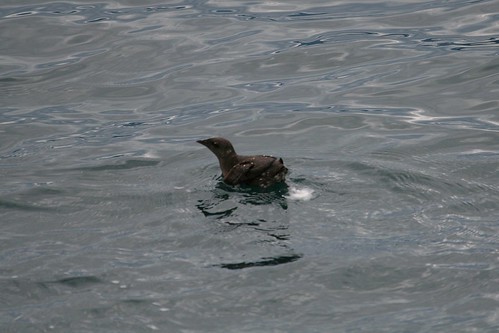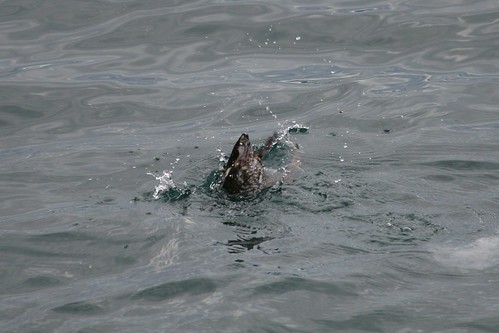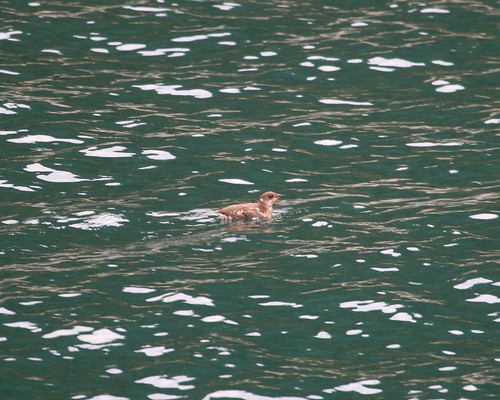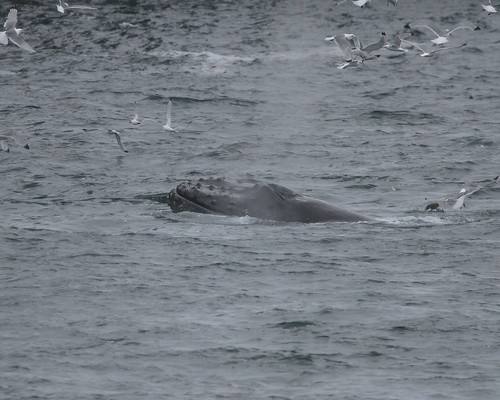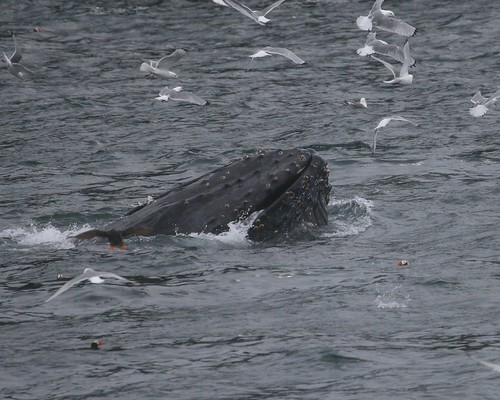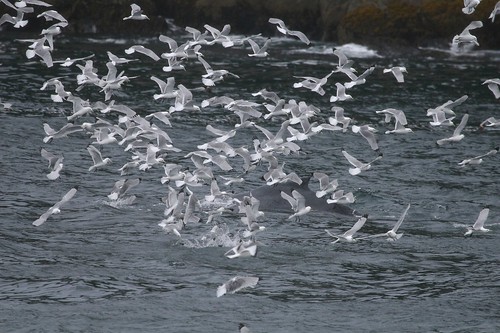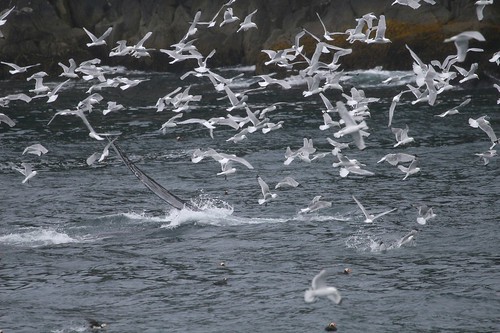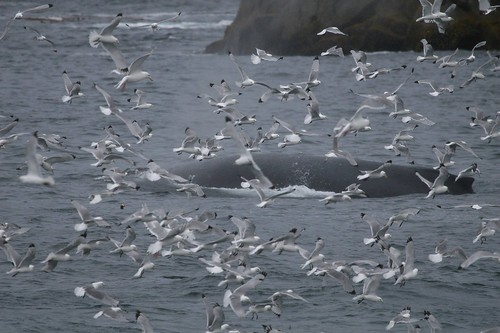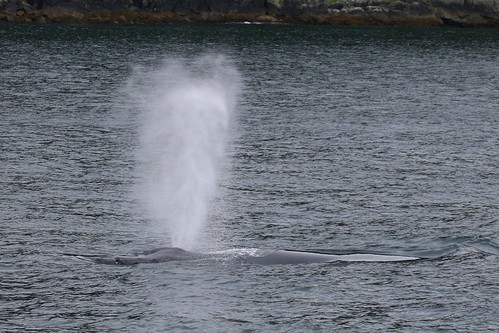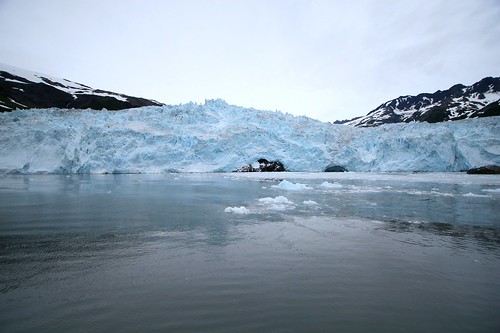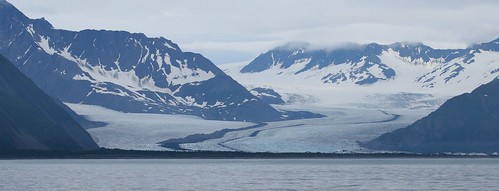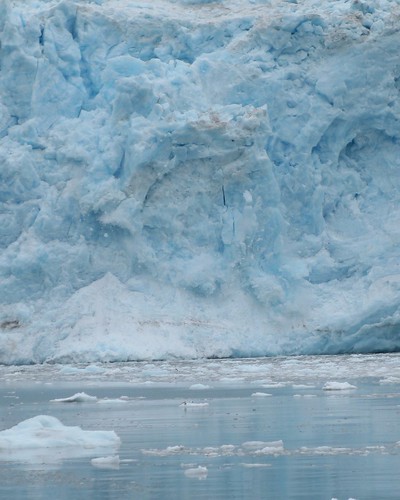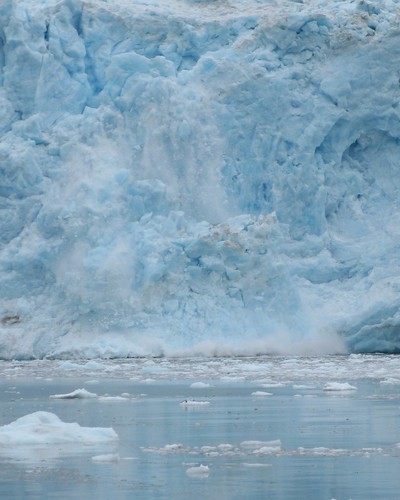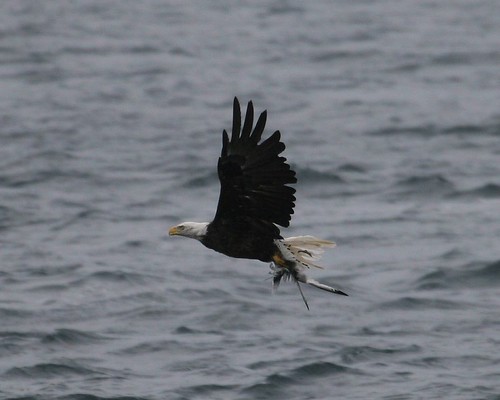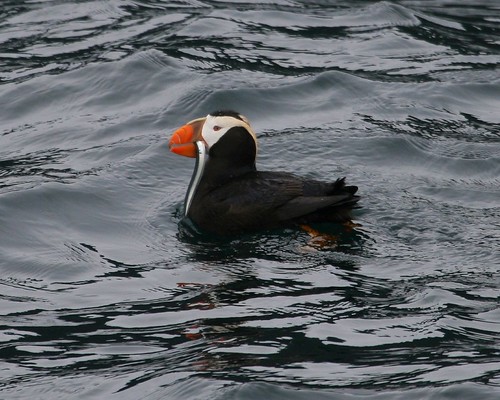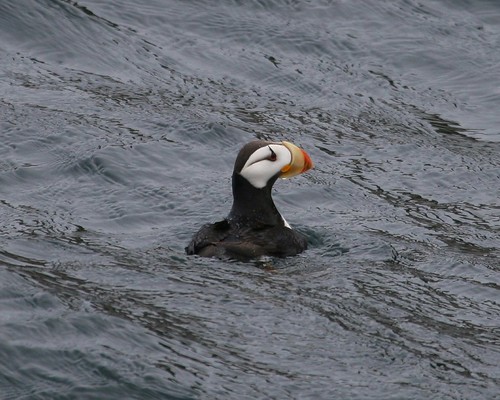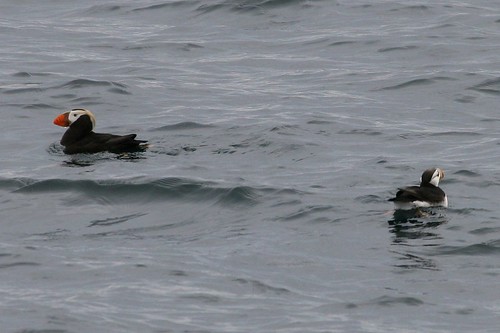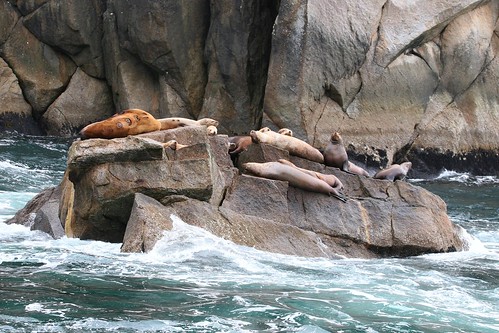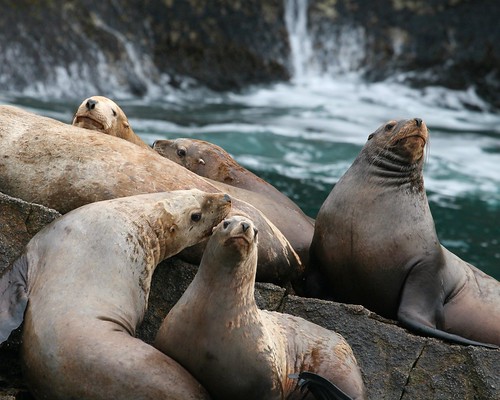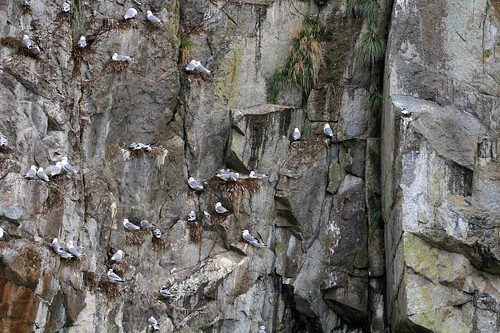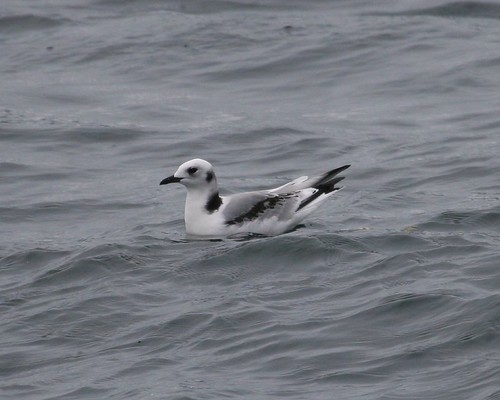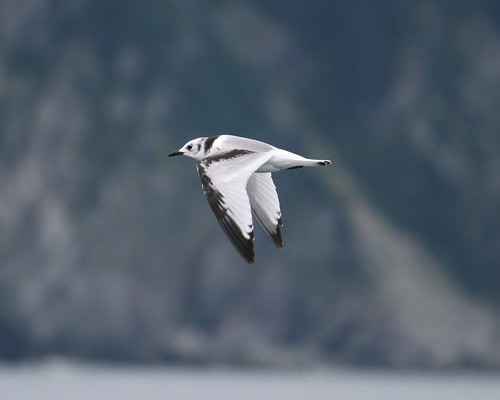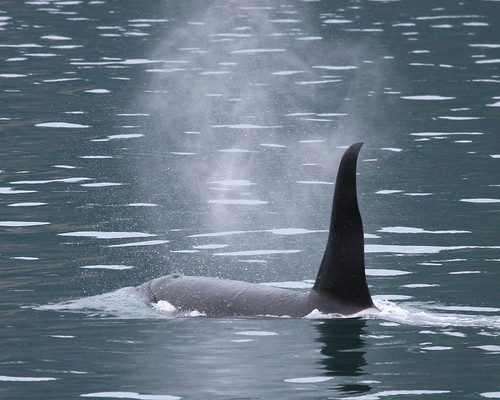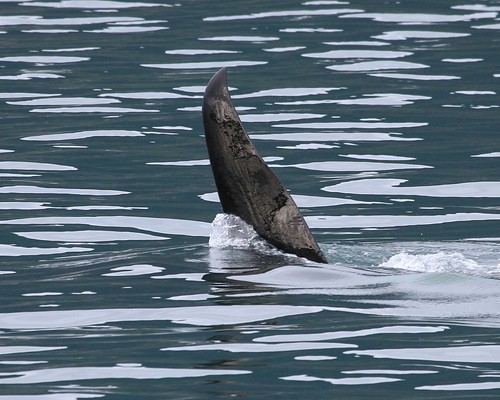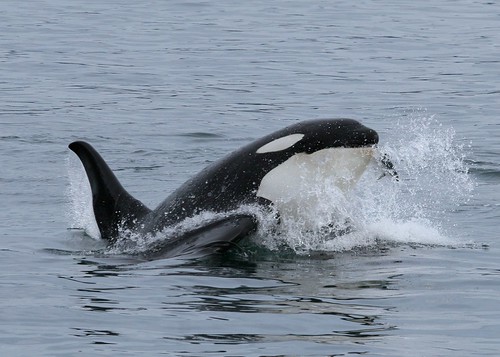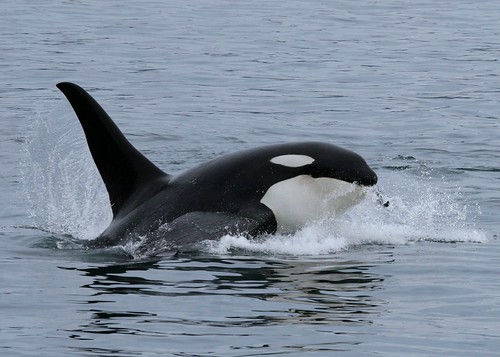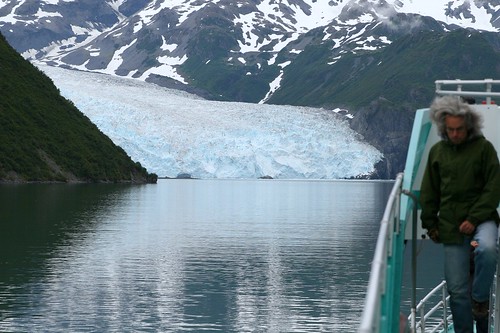While the boat cruised through the waters south of Seward, I saw Murrelets on several occasions. I tried to take photos of most of them, figuring that I could identify them later when I reviewed what my camera captured. But Murrelets are like little toys bobbing and diving in a giant bathtub. They are small birds. And on this day usually far away. When they were not so far, they would quickly dive under the waves as the boat approached. Despite my photos, most of the Murrelets went unidentified. I assume that they were Marbled Murrelets, but I really do not know.
The trio of photos below are three of the better photos that I managed to get. Of course, "better" does not mean "good". The focus on these is very soft. I can tell that the subjects really are Marbled Murrelets, so I guess the photos are not too soft, but I still wish I could have gotten better captures.
Humpback Whale
On the way back from Aialik Glacier, the boat cruised by several more of those rocky islands that the birds enjoy so much. As we approached one hunk of rock, the captain noticed something that piqued his interest. All I saw, however, was a rather large flock of birds just above the surface of the water.
I didn't have to wait very long to understand. A Humpback Whale surfaced right where all those birds were flocking.
The birds and the whale were after the same thing: fish. The whale was fishing from below, and the birds from above.
I wonder if any birds, in an ill-timed attempt at a fish, have ever been eaten by a whale. I don't see how the whale could avoid any bird that got in the way. And there were enough Kittiwakes, Gulls and Puffins taking their chances for a fish that it just seems inevitable that one of those birds would eventually end up as a bit of whale chow. If one did, I am not sure how I would even notice.
Eventually the whale moved in one direction, and our boat moved in another. The birds seemed to settle down as well. I think that meant that there were no more fish to be had. We got a few more glimpses of the whale surfacing, spray puffing up into the air, before we headed on our way.
I didn't have to wait very long to understand. A Humpback Whale surfaced right where all those birds were flocking.
The birds and the whale were after the same thing: fish. The whale was fishing from below, and the birds from above.
I wonder if any birds, in an ill-timed attempt at a fish, have ever been eaten by a whale. I don't see how the whale could avoid any bird that got in the way. And there were enough Kittiwakes, Gulls and Puffins taking their chances for a fish that it just seems inevitable that one of those birds would eventually end up as a bit of whale chow. If one did, I am not sure how I would even notice.
Eventually the whale moved in one direction, and our boat moved in another. The birds seemed to settle down as well. I think that meant that there were no more fish to be had. We got a few more glimpses of the whale surfacing, spray puffing up into the air, before we headed on our way.
Aialik Glacier
The boat trip we took from Seward was ultimately headed towards Aialik Glacier. This is a tidewater glacier. It terminates into the waters of Aialik Bay, and the tour boat could get fairly close to it.
Contrast that with Bear Glacier which had receded from the shoreline and there is now a lake and a thin strip of land between the glacier and Resurrection Bay. This is a distant photo of Bear Glacier as we cruised by. You can see its racing stripes (the dark line up the middle...called medial moraines). This occurs when two glaciers merge and their lateral moraines have gone from being on the outside of each individual glacier, to instead being on the inside of the combined glacier. If you look closely at the photo, you can see that there are two racing stripes at the very bottom of the glacier, and only one further up. The second racing stripe comes from a third glacier merging into the larger glacier (coming in from the left near the bottom).
When we got to Aialik Glacier, the captain cut the engines off and we just floated. Similar to when we stopped to watch the Orca, the silence was punctuated by the occasional sounds of Mother Nature. This time, instead of the sounds of whales breaching, the sounds were the very loud pops and groans of the glacier as it inched its way towards the sea. Every now and then you would see bits of the glacier crumble away into the water. Usually it was small debris that chattered as it rolled down the face, but every now and then it was a larger piece that calved off with a dramatic roar.
Contrast that with Bear Glacier which had receded from the shoreline and there is now a lake and a thin strip of land between the glacier and Resurrection Bay. This is a distant photo of Bear Glacier as we cruised by. You can see its racing stripes (the dark line up the middle...called medial moraines). This occurs when two glaciers merge and their lateral moraines have gone from being on the outside of each individual glacier, to instead being on the inside of the combined glacier. If you look closely at the photo, you can see that there are two racing stripes at the very bottom of the glacier, and only one further up. The second racing stripe comes from a third glacier merging into the larger glacier (coming in from the left near the bottom).
When we got to Aialik Glacier, the captain cut the engines off and we just floated. Similar to when we stopped to watch the Orca, the silence was punctuated by the occasional sounds of Mother Nature. This time, instead of the sounds of whales breaching, the sounds were the very loud pops and groans of the glacier as it inched its way towards the sea. Every now and then you would see bits of the glacier crumble away into the water. Usually it was small debris that chattered as it rolled down the face, but every now and then it was a larger piece that calved off with a dramatic roar.
Bald Eagle Clutching Kittiwake
At one point on the Seward boat trip I noticed a Bald Eagle flying by. I whipped the camera into position and snapped a bunch of photos, barely realizing that the Eagle had something clutched in its talons. Later on that night (or maybe even the next week), as I reviewed the photos I had taken, I realized that the "something" in the Eagle's talons was a bird. Or what was left of a bird. Hard to say.
After some staring, and head scratching, I came to the highly speculative conclusion that the victim used to be a juvenile Black-legged Kittiwake. There were certainly enough of those around for the Eagle to choose from. Unfortunately, I did not see how this particular Kittiwake came to be in the possession of the Eagle, so we will all have to use our imagination.
After some staring, and head scratching, I came to the highly speculative conclusion that the victim used to be a juvenile Black-legged Kittiwake. There were certainly enough of those around for the Eagle to choose from. Unfortunately, I did not see how this particular Kittiwake came to be in the possession of the Eagle, so we will all have to use our imagination.
Puffins
I am lucky. I had the opportunity in 2006 to see Atlantic Puffins. That was a tremendously cool experience, and something I am not likely to forget. This blog existed back then, so you can check out what I had to say about those Atlantic Puffins. Don't get your hopes up for a story of interest, a pile of information or a dose of opinion. My writing style in this blog has evolved just a "tad" between 2006 and now. I look back and chuckle. That Atlantic Puffin post was so...sparse.
Now fast forward to our boat trip out of Seward. How do I compare my Atlantic Puffin experience to this one? Well, for starters, the trip out of Seward was a double-puffin-experience (DPE). That's right! There were two species of puffin to be seen in the waters south of Seward. How cool is that?
First up is the Tufted Puffin. Sure enough, they look like a puffin. That massive bill is pretty unmistakable. But this species has those interesting pale yellow plumes that drape back over their head like highly coiffed bits of hair. The first photo shows one with a single fish hanging out of his bill. They can carry nearly twenty small fish in their bill, all lined up side by side. The second photo catches a Tufted Puffin just about to take flight. He also has a fish, but it is hanging out of the opposite side of his bill.
And then there is the Horned Puffin. No, he does not have real horns. Their "horn" is the dark line that juts up above their eye. Their breast and belly are white, and their bill has a broad yellow section near the base.
Here is a final photo that has a Tufted Puffin and a Horned Puffin in the same frame. The Horned Puffin kept turning his back on me, but you can still make some comparisons between the two.
Now fast forward to our boat trip out of Seward. How do I compare my Atlantic Puffin experience to this one? Well, for starters, the trip out of Seward was a double-puffin-experience (DPE). That's right! There were two species of puffin to be seen in the waters south of Seward. How cool is that?
First up is the Tufted Puffin. Sure enough, they look like a puffin. That massive bill is pretty unmistakable. But this species has those interesting pale yellow plumes that drape back over their head like highly coiffed bits of hair. The first photo shows one with a single fish hanging out of his bill. They can carry nearly twenty small fish in their bill, all lined up side by side. The second photo catches a Tufted Puffin just about to take flight. He also has a fish, but it is hanging out of the opposite side of his bill.
And then there is the Horned Puffin. No, he does not have real horns. Their "horn" is the dark line that juts up above their eye. Their breast and belly are white, and their bill has a broad yellow section near the base.
Here is a final photo that has a Tufted Puffin and a Horned Puffin in the same frame. The Horned Puffin kept turning his back on me, but you can still make some comparisons between the two.
Stellar Sea Lion
This is a group of Stellar Sea Lions lounging on a bit of convenient rock. The boat got fairly close to that rock, but the sea lions did not get spooked to the point of leaving their comfy perch. At worst, they just kept a close eye on us, but several just kept sleeping (meh...just another stoopid boat).
Stellar Sea Lions are undergoing some significant changes. There are two populations of Stellar Sea Lion: eastern (found on the eastern coast of Asia) and western (found on the western coast of North America). For some yet to be agreed upon reason, the western population has declined between 70% and 80% since the 1970's, and has been listed as endangered under the Endangered Species Act since 1990. There are lots of theories to help explain the decline (including decreasing populations of fish from climate change or our economy, increasing predation by Orca, disease, pollution, or some combination of each of these), but there is no consensus on which one(s) are the most likely.
Stellar Sea Lions are undergoing some significant changes. There are two populations of Stellar Sea Lion: eastern (found on the eastern coast of Asia) and western (found on the western coast of North America). For some yet to be agreed upon reason, the western population has declined between 70% and 80% since the 1970's, and has been listed as endangered under the Endangered Species Act since 1990. There are lots of theories to help explain the decline (including decreasing populations of fish from climate change or our economy, increasing predation by Orca, disease, pollution, or some combination of each of these), but there is no consensus on which one(s) are the most likely.
Black-legged Kittiwake
It sure is hard following up that last post with something just as exciting. After a little deliberation, I decided to post some pictures of Black-legged Kittiwake. Yeah...I agree. Kittiwakes are not nearly as exciting as an Orca breaching the surface in pursuit of a meal (if you didn't see that post, you should check it out).
Kittiwake. Such a fancy name for what is otherwise just another gull. I had to research it as I wrote this post, but it turns out that their name comes from the call they make. This one is the Black-legged variety (instead of the Red-legged variety), and it was a life bird for me. When we headed to Alaska, I was pretty sure I would end up seeing a Black-legged Kittiwake without really trying. I was right.
On our boat trip out of Seward, almost every gull we saw was a Black-legged Kittiwake. The boat trip took us past a few nesting locations. These were essentially small rock islands. If you imagine steep mountains that were, except for the very tip, submerged by water, then you can imagine the appearance of these islands. Only the birds found any use out of them, using any tiny bit of horizontal surface as a place to roost or nest.
The adults were fairly plain looking. White underneath, gray on top, a yellow bill with no black or red marks on it, and, of course, black legs. The tips of the wings were black with no white.
The first year birds, to me, had a much more interesting appearance. Their bills were black instead of yellow, and there were several spots and lines of black mixed in with the gray and white coloration.
Kittiwake. Such a fancy name for what is otherwise just another gull. I had to research it as I wrote this post, but it turns out that their name comes from the call they make. This one is the Black-legged variety (instead of the Red-legged variety), and it was a life bird for me. When we headed to Alaska, I was pretty sure I would end up seeing a Black-legged Kittiwake without really trying. I was right.
On our boat trip out of Seward, almost every gull we saw was a Black-legged Kittiwake. The boat trip took us past a few nesting locations. These were essentially small rock islands. If you imagine steep mountains that were, except for the very tip, submerged by water, then you can imagine the appearance of these islands. Only the birds found any use out of them, using any tiny bit of horizontal surface as a place to roost or nest.
The adults were fairly plain looking. White underneath, gray on top, a yellow bill with no black or red marks on it, and, of course, black legs. The tips of the wings were black with no white.
The first year birds, to me, had a much more interesting appearance. Their bills were black instead of yellow, and there were several spots and lines of black mixed in with the gray and white coloration.
Orca
It was about 30 minutes after we had pulled out of Seward harbor that the captain of the boat first cut his engines down to a quiet nothing. We had been heading south into Resurrection Bay when he noticed a pod of Killer Whales nearby. We were, of course, dripping with excitement. We expected to see some Killer Whales on this excursion, and right on cue they made themselves visible.
At first, we would see puffs of spray as the whales surfaced for air. There were several off in the distance, and we strained to see something that was recognizable as a Killer Whale. Occasionally we would see something that suggested that telltale black-and-white pattern, but the distance made it hard for me to connect what my eyes were seeing with what my imagination and eagerness wanted to see.
But then there was a closer puff of spray. Much closer.
I do not know how many Killer Whales were out there, but now we had at least one that was fairly close to the boat. I suspect there were several. The captain explained that they were likely feeding on salmon. With the boat's engines off it was super quiet. We just floated, and everyone on the boat stood and watched, not saying a word. And then, when one of the whales surfaced and cleared its blowhole, that sound would punctuate the silence and would carry over the distance of the water. We just floated and watched and ooohed and ahhhhed as those whales repeatedly surfaced and dove in the vicinity of the boat.
It did not occur to me prior to seeing these whales that it might be difficult to take a photograph of them as they came up for air. When they were underwater, they were invisible. When they did come up for air, your first clue was that sound of them exhaling. So when I heard that sound, I would whip around, aim my camera, trust the auto focus and AI Servo mode on my camera, and take a bunch of pictures. For me, this was a high effort, low reward approach.
Then I started to notice that several of the breaching whales were staying in the same general area. So I started to ignore all of the other whales that were around the boat, and instead focused on that one area. And my luck improved.
At first I only got a dorsal fin here and there.
But then I was finally looking at the right place at the right time. I had my camera up and ready to shoot when one of the whales surfaced hard in pursuit of some tasty little fish.
Wow! We were only 30 minutes into this eight hour trip and already I had seen (and managed to photograph) something that I will never forget.
At first, we would see puffs of spray as the whales surfaced for air. There were several off in the distance, and we strained to see something that was recognizable as a Killer Whale. Occasionally we would see something that suggested that telltale black-and-white pattern, but the distance made it hard for me to connect what my eyes were seeing with what my imagination and eagerness wanted to see.
But then there was a closer puff of spray. Much closer.
I do not know how many Killer Whales were out there, but now we had at least one that was fairly close to the boat. I suspect there were several. The captain explained that they were likely feeding on salmon. With the boat's engines off it was super quiet. We just floated, and everyone on the boat stood and watched, not saying a word. And then, when one of the whales surfaced and cleared its blowhole, that sound would punctuate the silence and would carry over the distance of the water. We just floated and watched and ooohed and ahhhhed as those whales repeatedly surfaced and dove in the vicinity of the boat.
It did not occur to me prior to seeing these whales that it might be difficult to take a photograph of them as they came up for air. When they were underwater, they were invisible. When they did come up for air, your first clue was that sound of them exhaling. So when I heard that sound, I would whip around, aim my camera, trust the auto focus and AI Servo mode on my camera, and take a bunch of pictures. For me, this was a high effort, low reward approach.
Then I started to notice that several of the breaching whales were staying in the same general area. So I started to ignore all of the other whales that were around the boat, and instead focused on that one area. And my luck improved.
At first I only got a dorsal fin here and there.
But then I was finally looking at the right place at the right time. I had my camera up and ready to shoot when one of the whales surfaced hard in pursuit of some tasty little fish.
Wow! We were only 30 minutes into this eight hour trip and already I had seen (and managed to photograph) something that I will never forget.
Kenai Fjords National Park
Our main purpose for visiting Seward was a boat trip. We signed up for a boat tour into Kenai Fjords National Park. This National Park was established in 1980, and most of its land is covered by the Harding Icefield. There is only one road in the park (which gets you very close to Exit Glacier). Your only other choices are visiting the park by foot or boat.
Several boat tours operate out of Seward. We elected to go with the aptly named Kenai Fjords Tours. They offered an 8.5 hour excursion with the chance to see lots of wildlife and several glaciers, and provided a couple of meals. They delivered on all counts, and I have no complaints. The target glacier for the trip was Aialik Glacier. My home-grown Google map shows where that is relative to Seward.
Neither Tammy and I have much experience on boats. I had previously taken a pelagic trip while in Maine for the 2006 ABA Convention. And Tammy had taken some type of boat trip into the ocean off of the coast of North Carolina at some point before we met. But that was about it. We are landlubbers. So we were just a tad nervous about this particular boat trip.
We knew we needed to dress for cold and wind and possible rain, and we were successful on that point. There were others on the boat that stayed on the inside, where it was warm and dry, because they did not come prepared. I am sure their experience was just fine, but I am glad that we had prepared such that we could stay outside the entire time (even when there was a light rain).
Also, neither of us were sure we would not get seasick. We fretted a bit over what to eat in the morning, and we even took a non-drowsy Dramamine before we got on the boat (if you take them after you feel ill, it is too late). We ended up being fine and did not feel ill. In hindsight, we probably did not even need the Dramamine.
My next several posts will share pictures from this boat trip. For this post, I wanted to share a picture of the boat we were on, but I did not take any pictures of it. Sheesh. Apparently, all my photos were of things away from the boat. I did, however, find this photo of Aialik Glacier that I took as the boat approached. You can kind of see the side of the boat, but one of our fellow tourists is there too. I needed a nice warm hat. He seemed to be fine with just the hair. Hmmm...maybe I should have cropped this photo...
But never mind him! check out that glacier!
Several boat tours operate out of Seward. We elected to go with the aptly named Kenai Fjords Tours. They offered an 8.5 hour excursion with the chance to see lots of wildlife and several glaciers, and provided a couple of meals. They delivered on all counts, and I have no complaints. The target glacier for the trip was Aialik Glacier. My home-grown Google map shows where that is relative to Seward.
Neither Tammy and I have much experience on boats. I had previously taken a pelagic trip while in Maine for the 2006 ABA Convention. And Tammy had taken some type of boat trip into the ocean off of the coast of North Carolina at some point before we met. But that was about it. We are landlubbers. So we were just a tad nervous about this particular boat trip.
We knew we needed to dress for cold and wind and possible rain, and we were successful on that point. There were others on the boat that stayed on the inside, where it was warm and dry, because they did not come prepared. I am sure their experience was just fine, but I am glad that we had prepared such that we could stay outside the entire time (even when there was a light rain).
Also, neither of us were sure we would not get seasick. We fretted a bit over what to eat in the morning, and we even took a non-drowsy Dramamine before we got on the boat (if you take them after you feel ill, it is too late). We ended up being fine and did not feel ill. In hindsight, we probably did not even need the Dramamine.
My next several posts will share pictures from this boat trip. For this post, I wanted to share a picture of the boat we were on, but I did not take any pictures of it. Sheesh. Apparently, all my photos were of things away from the boat. I did, however, find this photo of Aialik Glacier that I took as the boat approached. You can kind of see the side of the boat, but one of our fellow tourists is there too. I needed a nice warm hat. He seemed to be fine with just the hair. Hmmm...maybe I should have cropped this photo...
But never mind him! check out that glacier!
Subscribe to:
Comments (Atom)
